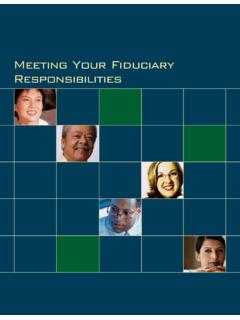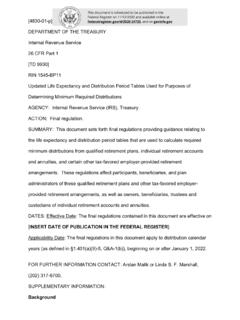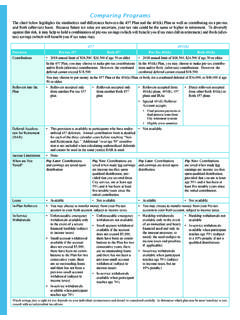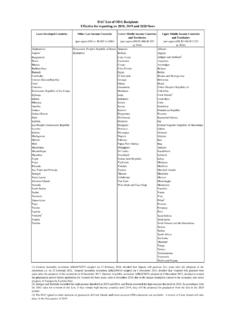Transcription of I. PURPOSE AND OVERVIEW - IRS tax forms
1 1 ADDITIONAL RELIEF FOR CORONAVIRUS DISEASE (COVID-19) UNDER 125 CAFETERIA PLANS Notice 2021-15 I. PURPOSE AND OVERVIEW This notice clarifies the application of 214 of the Taxpayer Certainty and Disaster Tax Relief Act of 2020 (the Act), recently enacted as Division EE of the Consolidated Appropriations Act, 2021, Pub. L. 116-260, 134 Stat. 1182 (Dec. 27, 2020), which provides temporary special rules for health flexible spending arrangements (health FSAs) and dependent care assistance programs1 under 125 cafeteria plans. As described more fully below, 214 of the Act: Provides flexibility with respect to carryovers of unused amounts from the 2020 and 2021 plan years; Extends the permissible period for incurring claims for plan years ending in 2020 and 2021; Provides a special rule regarding post-termination reimbursements from health FSAs during plan years 2020 and 2021; Provides a special claims period and carryover rule for dependent care assistance programs when a dependent ages out during the COVID-19 public health emergency.
2 And 1 Although 214 of the Act refers to dependent care flexible spending arrangements, this notice uses the term dependent care assistance programs. 2 Allows certain mid-year election changes for health FSAs and dependent care assistance programs for plan years ending in 2021. This notice also provides additional relief with respect to mid-year elections for plan years ending in 2021. Specifically, with respect to employer-sponsored health coverage, a 125 cafeteria plan may permit employees who are eligible to make salary reduction contributions under the plan to take any of the following actions for plan years ending in 2021: (1) make a new election on a prospective basis, if the employee initially declined to elect employer-sponsored health coverage; (2) revoke an existing election and make a new election to enroll in different health coverage sponsored by the same employer on a prospective basis.
3 And (3) revoke an existing election on a prospective basis, provided that the employee attests in writing that the employee is enrolled, or immediately will enroll, in other health coverage not sponsored by the employer. The notice also provides relief with respect to the effective date of amendments to 125 cafeteria plans and health reimbursement arrangements (HRAs) to implement the expansion of allowed expenses for health FSAs and HRAs by the Coronavirus Aid, Relief, and Economic Security Act (CARES Act), Pub. L. 116-136, 134 Stat. 281 (March 27, 2020) to include over-the-counter drugs without prescriptions and menstrual care products.
4 II. BACKGROUND A. Elections Under a 125 Cafeteria Plan Section 125(d)(1) of the Internal Revenue Code (Code) defines a 125 cafeteria plan as a written plan maintained by an employer under which all participants are 3 employees, and all participants may choose among two or more benefits consisting of cash and qualified benefits. Subject to certain exceptions, 125(f) defines a qualified benefit as any benefit which, with the application of 125(a), is not includable in the gross income of the employee by reason of an express provision of the Code. Qualified benefits that may be provided under a 125 cafeteria plan include, but are not limited to, employer-provided accident and health plans excludable under 105(b) and 106, health FSAs excludable under 105(b) and 106, and dependent care assistance programs excludable under 129.
5 Elections regarding qualified benefits under a 125 cafeteria plan generally must be irrevocable and must be made prior to the first day of the plan year, except as provided under Treas. Reg. Treas. Reg. provides that a 125 cafeteria plan may permit an employee to revoke an election during a period of coverage and to make a new election under certain circumstances, such as if the employee experiences a change in status or there are significant changes in the cost of coverage. Section 125 does not require a 125 cafeteria plan to permit the mid-year election changes allowed under Treas. Reg. B. Health FSAs and Dependent Care Assistance Programs Carryovers and Grace Periods A 125 cafeteria plan may permit the carryover of unused amounts remaining in a health FSA as of the end of a plan year to pay or reimburse a participant for medical care expenses incurred during the following plan year, subject to the carryover limit (the 4 carryover rule).
6 2 See Notice 2013-71, 2013-47 IRB 532, and Notice 2020-33, 2020-22 IRB 868. In the alternative, a 125 cafeteria plan may permit a participant to apply unused amounts (including amounts remaining in a health FSA or dependent care assistance program) at the end of the plan year to pay expenses incurred for those same qualified benefits during a period of up to two months and 15 days immediately following the end of the plan year (the grace period rule). See Notice 2005-42, 2005-1 1204, and Prop. Treas. Reg. (e). For a health FSA, a 125 cafeteria plan may adopt a carryover or a grace period (or neither) but may not adopt both features.
7 See Notice 2013-71. Under generally applicable rules, without regard to 214 of the Act, a 125 cafeteria plan may not adopt a carryover for a dependent care assistance program. In Notice 2020-29, 2020-22 IRB 864, the Department of the Treasury (Treasury Department) and the Internal Revenue Service (IRS) explained that, due to the nature of the COVID-19 public health emergency and unanticipated changes in the availability of certain medical care and dependent care, employees may be more likely to have unused health FSA amounts or dependent care assistance program amounts at the end of plan years, or grace periods, ending in 2020.
8 To provide related relief, Notice 2020-29 extended, to the end of calendar year 2020, the period during which employees could be permitted to apply unused health FSA amounts and dependent care assistance program amounts remaining as of the end of a grace period or plan year 2 The maximum unused amount remaining in a health FSA from a plan year beginning in 2020 allowed to be carried over to the plan year beginning in 2021 is $550 (20 percent of $2,750, the indexed 2020 limit under 125(i)). 5 ending in 2020 to pay or reimburse medical care expenses or dependent care expenses. C. Impact of Health FSA Reimbursements on Eligibility to Contribute to an HSA Section 223 of the Code permits eligible individuals to establish and contribute to health savings accounts (HSAs).
9 Pursuant to 223(c)(1)(A), an eligible individual is, with respect to any month, any individual if (i) the individual is covered under a high deductible health plan (HDHP) as of the first day of the month, and (ii) the individual is not, while covered under an HDHP, covered under any health plan which is not an HDHP and which provides coverage for any benefit which is covered under the HDHP. An HDHP is a health plan that satisfies the minimum annual deductible requirement and maximum out-of-pocket expenses requirement under 223(c)(2)(A). Coverage by a general PURPOSE health FSA disqualifies an otherwise eligible individual from contributing to an HSA, although coverage by an HSA-compatible health FSA, such as a limited PURPOSE health FSA or a post-deductible health FSA, would not do See Rev.
10 Rul. 2004-45, 2004-1 971. III. GUIDANCE RELATED TO SECTION 214 OF THE ACT A. Section 214 Carryovers for Health FSAs and Dependent Care Assistance Programs 3 Notice 2005-86, 2005-49 IRB 1075, clarifies that coverage by a general PURPOSE health FSA during a grace period is health coverage that disqualifies an otherwise eligible individual from contributing to an HSA during that period. However, Notice 2005-86 provides methods an employer can use to amend the health FSA for the grace period so it does not disqualify employees from contributing to an HSA during that period. For a more detailed discussion of these options, see section of this notice.
















